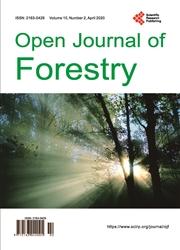Assessment of Tree Diversity and Abundance in Rashad Natural Reserved Forest, South Kordofan, Sudan
引用次数: 7
Abstract
This study aims to estimate the tree diversity status of Rashad Forest Reserves in the Rashad locality of the South Kordofan State of Sudan. For data collection, eight sample plots (20 × 20 m) were taken randomly, and parameters were determined: trees species diversity, composition, relative density, dominance, important value index, and species richness in the Rashad forest reserve. The results show that a total of 237 and 56 tree species, including 22 families, have been identified in the study area. Fabaceae family and species numbers have the highest number of 13 species in 8 genera, followed by Combretaceae with 8 species belonging to 3 different genera, Malvaceae with 5 species belonging to 4 different genera, Apocynaceae with 3 species belonging to 3 different genera. The Arecaceae, Burseraceae, Capparaceae, Euphorbiaceae, Meliaceae, and Rubiaceae families each had two species, and all the other 11 families had one species each. Among the 56 different tree species found within the reserve. The results also indicated that Tamarindus indica L. and Ziziphus spina-christi (L.) Desf. had the highest relative density and dominance of 4.64% and 11% respectively. Adansonia digitata L., Grewia villosa Willd, Vepris nobilis (Delile) Mziray had density and dominance of 4.80% and 9%. Followed by Anogeissus leiocarpa (DC.) Guill. & Perr, Adansonia digitata L., Catunaregam nilotica (Stapf) Tirveng. (Syn: Xeromphis nilotica (Stapf) Keay, Vangueria madagascariensis J. F. Gmel. with 3.38% and 8%, respectively. Eleven species recorded the least relative dominance of 0.42%. Shannon-Weiner diversity index (H’) value stood at 3.82. And as diversity indices varied with location depending on the species available within an ecological zone, Rashad forest reserve is blessed with a moderate diversity index.苏丹南科尔多凡Rashad自然保护林树木多样性和丰富度评估
本研究旨在评估苏丹南科尔多凡州拉沙德地区拉沙德森林保护区的树木多样性状况。为了收集数据,随机选取了8个样地(20×20m),并确定了参数:拉沙德森林保护区的树木物种多样性、组成、相对密度、优势度、重要价值指数和物种丰富度。结果表明,研究区共鉴定出237种和56种树木,包括22科。Fabaceae科和种数最多,有8属13种,其次是Combretaceae科,有3个不同属8种,锦葵科,有4个不同属5种,夹竹桃科,有三个不同属3种。Arecaceae、Burseraceae、Capparaceae、Euphorbaceae、Meliaceae和Rubiaceae科各有两个种,其余11个科各有一个种。在保护区内发现的56种不同的树种中。研究结果还表明,罗望子和酸枣具有一定的遗传多样性。相对密度和优势度最高,分别为4.64%和11%。洋地黄(Adansonia digitata L.)、绒毛灰蝶(Grewia villosa Willd)、野豌豆(Vepris nobilis(Delile)Mziray)的密度和优势度分别为4.80%和9%。紧随其后的是Anogeissus leiocarpa(DC)Guill。&Perr,Adansonia digitata L.,Catunaregam nilotica(Stapf)Tirveng。(Syn:Xeromphis nilotica(Stapf)Keay,Vangueria madagascarensis J.F.Gmel。分别为3.38%和8%。11个物种的相对优势度最低,为0.42%,Shannon Weiner多样性指数(H')值为3.82。由于多样性指数因生态区内可用物种的不同而不同,拉沙德森林保护区的多样性指数适中。
本文章由计算机程序翻译,如有差异,请以英文原文为准。
求助全文
约1分钟内获得全文
求助全文

 求助内容:
求助内容: 应助结果提醒方式:
应助结果提醒方式:


